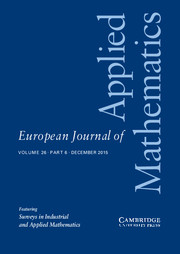Article contents
A model for speed adaptation of individuals and existence of weak solutions
Published online by Cambridge University Press: 01 July 2003
Abstract
When individuals move together in large groups, as seen in schools of fish, they adapt their speed and direction to that of their neighbours. We present and analyse a model for the speed adaptation process in the case in which all individuals move in the same or in two opposite directions. The model consists of a hyperbolic conservation law for the density of individuals coupled to a parabolic or elliptic equation for speed. A detailed linear analysis reveals several mechanisms for the appearance of instabilities of the homogeneous steady state, which trigger the formation of schools, herds, flocks, etc. Long-term existence of weak solutions is shown using the vanishing viscosity approach.
- Type
- Papers
- Information
- Copyright
- 2003 Cambridge University Press
- 5
- Cited by


